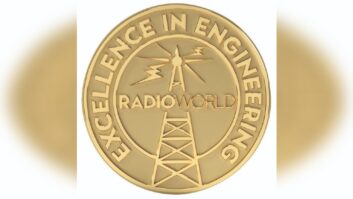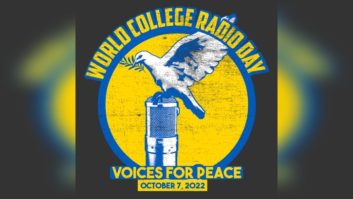Jeff Littlejohn is the recipient of Radio World’s 2008 Excellence in Engineering Award.
Recipients represent the highest ideals of the U.S. radio broadcast engineering profession and reflect those ideals through contributions to the industry.
Jeff is the executive vice president of distribution development and is responsible for the oversight of technical aspects of the radio division at Clear Channel.
Answering to Radio President/CEO John Hogan, he oversees radio engineering matters including 400 or so engineers, capital management and radio’s interface with IT. His team handles intellectual property issues, online technology and the hundreds of computer servers and distribution networks that handle Clear Channel content.
But as his title suggests, a key task is to find and build new ways to distribute that content. Beyond Clear Channel’s main analog AM and FM outlets, that means platforms like HD Radio, RDS, cellular technologies, Internet streaming and podcasting.
Platforms
Littlejohn — who has an associates degree in electronics and a bachelor’s in automated manufacturing from ITT Technical Institute in Indiana — started his career in Ft. Wayne, Ind., as an assistant engineer with WAJI and built much of their studios.
He pulled wire through ceilings, put wires on punch blocks and learned from the ground up; among his teachers was Jack Didier, who is now DOE for Federated Media. Later he worked for Didier and Jeff Goode at Broadcast Circuit Systems, a contract engineering company serving Ohio and Indiana. He then worked for WBYR(FM) when that station moved into Ft. Wayne, and for Beasley in Chicago.
Littlejohn went to work in 1992 for American Media, which owned about 15 radio stations, and he hasn’t left a job since, though the employer name on the business cards certainly has evolved — from American Media to Chancellor Broadcasting to AMFM Inc. to Clear Channel.
Clear Channel has 983 AM/FM stations, more than 1,000 Web sites and 105 million listeners in four countries. I asked Jeff how many channels this all works out to; he figures at least 1,500 unique channels, including 350 HD2s and a few HD3s.
“Clearly AM and FM analog are our primary means of distribution right now; HD Radio is probably the most [notable] upcoming means. But we’re also making fantastic progress on streaming in multiple formats in various types of devices. Cellular distribution with Sprint, US Cellular, Metro PCS; things like the iPhone.”
Clear Channel, he says, decided early to concentrate on finding out what content listeners wanted. “It should not matter to us whether they want to receive that over the air or online. Radio should not lose sight of the listener. The challenge we have to expand on is: Who is that listener? Do they only count if they’re listening on AM or FM? Of course not…As long as they’re listening to our content, aren’t they still a listener?
“John Hogan has been quoted as saying we’re no longer a company of just tall towers and big fields. We need to get beyond the unique channel we have for distribution; we need to make sure we follow our listeners.”
Jeff’s team also is responsible for distributing content from other companies; for instance, most of the network that Microsoft uses to distribute content over MSN Direct is on Clear Channel signals.
Digital push
One of his priorities is working with manufacturers to get HD Radios into cars, preferably as standard equipment. While HD Radio hasn’t taken off as quickly as he’d hoped, he sees momentum coming.
“That’s going to be a game changer for radio, having an additional content channel inside the vehicle. That’ll be one of those things that we’ll look back on 10 or 15 years from now and say we changed broadcasting.”
But with broadband coming to the auto environment, isn’t all this going to be moot? “It’s possible; but that’s why we need to move quickly. We waited too long to begin with, and satellite got a jump ahead of us; we need HD Radio to be standard in every vehicle.
“The thing radio will have is that it’s free to the consumer. It’s almost a right, to be able to receive free content. WiMax is interesting; I know there are some automakers looking at it, but there is no nationwide WiMax infrastructure in place today, probably won’t be for a few years; and there are no receivers being installed in cars today and there probably won’t be for a few years.
“Beyond that, we shouldn’t see wireless broadband as a problem but an opportunity. We should be looking at ways to make our content available into the vehicle.”
Traffic data
To that end, in 2004 Littlejohn headed the team that established Clear Channel Radio’s Total Traffic Network; it collects info from traffic cameras, speed sensors, police scanners and mobile reporters and then delivers the data to consumers.
This is the first RDS Traffic Message Channel traffic service in North America. It has contracted to 30 clients; it recently surpassed a half-million paid subscribers and reaches 125 markets in four countries.
Among companies using its data in automobile systems are BMW, Mini USA and Volvo, which offer it as a standard service, no subscription. Portable nav systems using the data include ASUS, Garmin, TomTom, NAVIGON, Mio Technology, Delphi, Kenwood, Clarion, Harmon Kardon, Panasonic, Siemens and Cobra Electronics.
Buy this
Looking to make radio more interactive, Littlejohn is excited about tagging — not only via Apple iTunes tagging of digital signals, as previously announced, but with analog RDS.
In September, Clear Channel joined with eight other groups to announce they will support RDS song tagging using technology from Jump2Go; further, Microsoft Zune portable media players, including those in the field, now will allow users to tag and immediately retrieve songs broadcast from those stations.
A song tag is an encrypted digital code embedded in the FM broadcast. When a listener tags a tune, the code is stored on their MP3 player. Zune’s FM tuner and wireless connectivity let the player retrieve the song from an online Zune site as long as the user is in a WiFi hotspot.
“Clear Channel had the ability to do this tagging, but we wanted to work with Jump2Go because we knew other broadcasters were going to need to implement this as well,” Jeff said.
“We needed more than Clear Channel and Apple supporting tagging; we need to have more than HD Radio supporting tagging. My hope is that we’re able to be really impactful in making radio interactive and bringing it into the avant-garde. More than half of music that’s discovered is discovered on AM/FM radio; and more purchases are happening online.”
The RDS/Zune announcement combines those trends in a way that strengthens radio’s involvement in music discovery. With an installed base of Zunes that can be upgraded retroactively, Littlejohn hopes the impact could be felt as soon as this Christmas season.
Meanwhile, on the digital side, all of Clear Channel’s HD Radio and HD2 stations are iTunes Tagging compatible. If tagging’s proponents are right, more announcements will follow and tagging will become a sought-after feature regardless of whether a station is digital.
Though much of his time is spent on new tech projects, the traditional engineering infrastructure must be maintained. Steve Davis carries the bulk of that oversight, but Littlejohn made sure I knew about Clear Channel’s evolving disaster readiness program, which developed partly in reaction to all of the hurricanes of recent years.
The company now keeps emergency broadcast equipment stored around the country; it has an inventory of vehicles and generators on call and a Ku band satellite network ready that can deliver audio from anyplace to anyplace on short notice to help restore service from a studio to a transmitter site on an ad hoc basis.
Jeff is 42. He and his wife Tina have been married since 1989; their son Jacob is three. Tina and Jacob probably wish they could see more of him; Jeff just hit the 1 million mile mark on his frequent flyer account.
But with all those new channels and ventures to worry about — Total Traffic, HD Radio rollouts, data services, tagging, car receivers, mobile content — it’s no wonder he’s on the road a lot. He also is a notable contributor to the National Radio Systems Committee and several groups within the National Association of Broadcasters; and he sits on the board of iBiquity Digital Corp.
We honor Jeff Littlejohn for his excellence in traditional engineering as well as his leadership in how our medium develops its new channels, data tools and operating models.












